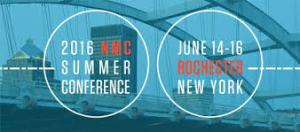The first full day of the NMC (New Media Consortium) 2016 Summer Conference here in Rochester, New York is far from over, but we’re already seeing signs that it’s a wonderfully transformative gathering of educator/trainer/ed-tech innovators from all over the world.
 Our minds are exploding with ideas coming from formal sessions, informal hallway and over-meal conversations, and online interactions with colleagues who are here even though they’re actually participating via Twitter and other online platforms rather than traveling hundreds or thousands of miles to join the party. Our vocabulary and our approach to teaching-training-learning-doing is growing as a result of the exchanges—one person in the “Rethinking Digital Literacy” session I facilitated earlier this afternoon, for example, expanded our richly-descriptive vocabulary by observing that “I’m in a room with a bunch of ‘hyper-normals.’” And many of us are already committing to concrete actions we will take, when we return to our day-to-day learning landscapes, as a result of what we are learning/experiencing/discussing here.
Our minds are exploding with ideas coming from formal sessions, informal hallway and over-meal conversations, and online interactions with colleagues who are here even though they’re actually participating via Twitter and other online platforms rather than traveling hundreds or thousands of miles to join the party. Our vocabulary and our approach to teaching-training-learning-doing is growing as a result of the exchanges—one person in the “Rethinking Digital Literacy” session I facilitated earlier this afternoon, for example, expanded our richly-descriptive vocabulary by observing that “I’m in a room with a bunch of ‘hyper-normals.’” And many of us are already committing to concrete actions we will take, when we return to our day-to-day learning landscapes, as a result of what we are learning/experiencing/discussing here.
As always, the learning begins at the moment we arrive in the conference city. Many of us start running into each other in hotel lobbies, coffee shops, restaurants, or local cultural centers even before the first formal onsite session begins. We also begin interacting via conference backchannels on Twitter; through our own pre-conference preparation including reading and blogging; pre-conference meals; and, sometimes, through phone calls with colleagues who cannot be here or are not yet here. It continues through the formal keynote/plenary sessions, like the engaging and inspiring “Games, Learning, and Society” presentation by Constance Steinkuehler that opened the NMC 2016 Summer Conference this morning.
Steinkuehler set a wonderful tone for the learning through numerous pithy, insightful observations, including the ideas that all game are models and simulations of something; that games are architecture for engagement—designed to be sticky; that games are vehicles for interest-based learning; and that games can make students care about what they’re learning by sparking curiosity.

A 2015 webinar title captures the essence of the current conference
Breakout sessions on a variety of topics have offered—and will continue to offer—engaging opportunities to hear our best colleagues bringing us up to date on ed-tech trends, challenges, and developments. A lunch-time town-hall meeting gave us an opportunity to discuss and influence the future of NMC onsite as well as online through an NMCNext website. A playful “Five Minutes of Fame” session later today will expose us to a variety of cutting-edge case studies. And informal “Idea Lab” offerings tomorrow capture “the best in big thinking from the NMC community” so we can “learn about the latest edtech projects through interactives, posters, and all kinds of formats that showcase how the future of learning is happening right now,” conference organizers tell us in the official conference program booklet.
All of this is what NMC as a highly-focused, extremely collaborative, and forward-thinking community of learning does best. It provides us with a blended onsite-online platform to engage and explore opportunities for thinking and for action in the ed-tech arena. It brings us together in ways we would not otherwise convene and encounter and interact with each other. It supports a process of contributing to positive transformation at a local, regional, national, and international level. And it knows enough to make sure that all of this is fun, inspiration, and capable of producing concrete results.
